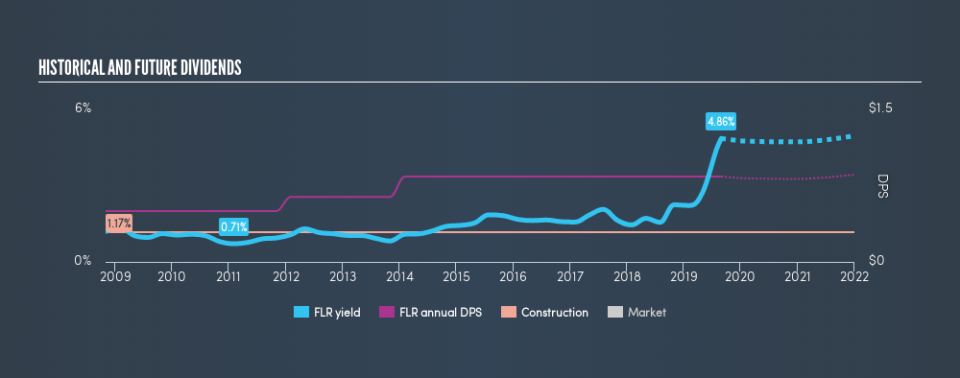Dividend Investors: Don't Be Too Quick To Buy Fluor Corporation (NYSE:FLR) For Its Upcoming Dividend

It looks like Fluor Corporation (NYSE:FLR) is about to go ex-dividend in the next 3 days. You will need to purchase shares before the 3rd of September to receive the dividend, which will be paid on the 2nd of October.
Fluor's next dividend payment will be US$0.21 per share, on the back of last year when the company paid a total of US$0.84 to shareholders. Looking at the last 12 months of distributions, Fluor has a trailing yield of approximately 4.9% on its current stock price of $17.3. If you buy this business for its dividend, you should have an idea of whether Fluor's dividend is reliable and sustainable. That's why we should always check whether the dividend payments appear sustainable, and if the company is growing.
View our latest analysis for Fluor
Dividends are typically paid out of company income, so if a company pays out more than it earned, its dividend is usually at a higher risk of being cut. Fluor's dividend is not well covered by earnings, as the company lost money last year. This is not a sustainable state of affairs, so it would be worth investigating if earnings are expected to recover. Given that the company reported a loss last year, we now need to see if it generated enough free cash flow to fund the dividend. If cash earnings don't cover the dividend, the company would have to pay dividends out of cash in the bank, or by borrowing money, neither of which is long-term sustainable. It paid out more than half (64%) of its free cash flow in the past year, which is within an average range for most companies.
Click here to see the company's payout ratio, plus analyst estimates of its future dividends.
Have Earnings And Dividends Been Growing?
Businesses with shrinking earnings are tricky from a dividend perspective. If earnings decline and the company is forced to cut its dividend, investors could watch the value of their investment go up in smoke. Fluor was unprofitable last year and, unfortunately, the general trend suggests its earnings have been in decline over the last 5 years, making us wonder if the dividend is sustainable at all.
Many investors will assess a company's dividend performance by evaluating how much the dividend payments have changed over time. In the last 10 years, Fluor has lifted its dividend by approximately 5.3% a year on average.
Get our latest analysis on Fluor's balance sheet health here.
The Bottom Line
From a dividend perspective, should investors buy or avoid Fluor? It's hard to get used to Fluor paying a dividend despite reporting a loss over the past year. At least the dividend was covered by free cash flow, however. Overall it doesn't look like the most suitable dividend stock for a long-term buy and hold investor.
Ever wonder what the future holds for Fluor? See what the 11 analysts we track are forecasting, with this visualisation of its historical and future estimated earnings and cash flow
We wouldn't recommend just buying the first dividend stock you see, though. Here's a list of interesting dividend stocks with a greater than 2% yield and an upcoming dividend.
We aim to bring you long-term focused research analysis driven by fundamental data. Note that our analysis may not factor in the latest price-sensitive company announcements or qualitative material.
If you spot an error that warrants correction, please contact the editor at editorial-team@simplywallst.com. This article by Simply Wall St is general in nature. It does not constitute a recommendation to buy or sell any stock, and does not take account of your objectives, or your financial situation. Simply Wall St has no position in the stocks mentioned. Thank you for reading.

 Yahoo Finance
Yahoo Finance 
